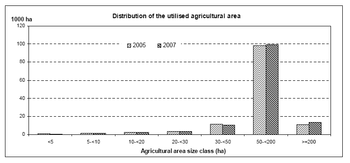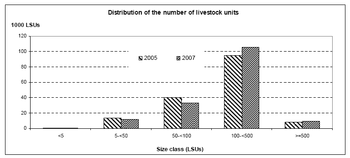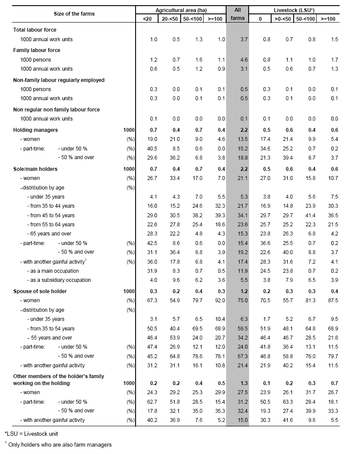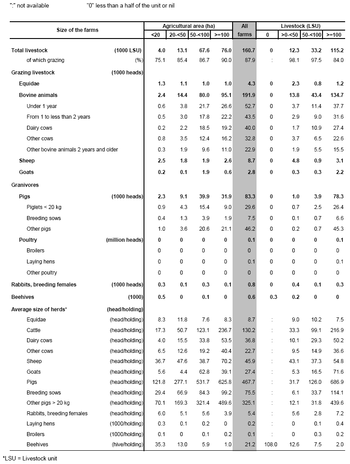Archive:Farm structure in Lithuania - 2007 results
- Data from May 2008, most recent data: Further Eurostat information, Main tables and Database.
This article is part of a series of country-specific essays on the results of the European Union Farm structure survey 2007. It provides a brief but nevertheless comprehensive insight into farm structure in Lithuania.
The 2007 FSS recorded 230 000 agricultural holdings in Lithuania, which represents a 9 % decrease since 2005. This drop results mainly from a fall of 36 % in the number of medium size holdings (from 5 to 50 ha).
Main statistical findings
Number of medium size holdings: - 36 % from 2005 to 2007
In 2007, about 85 300 agricultural holdings in Lithuania had an economic size of at least one European size unit, compared to 128 600 in 2005.
These farms made use of 2.1 million hectares (ha) of utilized agricultural area, which makes the average size of a holding in Lithuania 25 ha (compared to 18.2 ha in 2005). See Graph 1 for the distribution of UAA in terms of farm size, while Table 2 describes the size distribution and other characteristics of the agricultural holdings.
These holdings employed 111 200 annual work units (AWUs), the equivalent of 111 200 people working full time, a decrease of 27 % since 2005. This drop results mainly from the decrease in the labour force in medium size farms (<50ha). The organization and distribution of the labour force in Lithuania is described in Graph 2 and Table 1).
The farms contained 0.9 million livestock units (LSU) in 2007, 19.5 % less than in 2005. The distribution of livestock by farm size is shown in Table 4 and Graph 3.
Amongst the 85 300 agricultural holdings in 2007:
- 50 % made use of less than one AWU, while another 9.5 % made use of two or more AWUs;
- 23 % used less than 5 ha, while 8 % used 50 ha or more;
- 28 % of Lithuanian farms were producing mainly for own consumption, almost 15 000 holdings fewer than in 2005;
- 33 % were specialists in mixed cropping;
- 45 % were engaged in mixed livestock; and
- 22 % were mixed farms.
Amongst the sole holders:
- 38 % were women in 2007 (as in 2005);
- 48 % were aged 55 or more and 6 % were younger than 35 years; and
- 33 % had another gainful activity in 2007 (compared to 28 % in 2005).
In Lithuania in 2007, 44 % of the agricultural area was owned by the holders (more than 70 % in the holdings with less than 20 hectares).
The family labour force labour force has decreased from 2005 to 2007 (-34 %), in contrast to non family labour force.
The area farmed under organic production methods represents 53 353 ha (2.5 % of the utilised agricultural area, compared to 0.6 % in 2005). Details of land use by size of farm are given in Table 3.
The situation for subsistence farming in Lithuania is outlined in Table 5.
Data sources and availability
Due to the different coverage of the FSS across Member States, the total number of farms is not comparable between countries. This is why the present analysis, including Tables 1-4 and the graphs focus on holdings of at least one European size unit.
The survey on the structure of agricultural holdings in Lithuania was carried out between 1st and 29th June 2007 on a sample basis. Prior to this survey, a full-scale agricultural census was last conducted in 2003 and the sample farm structure survey in 2005. The reference day of the farm structure survey was the 1st June 2007, for the crops characteristics the area under winter crops sown in autumn 2006 and the area under summer crops sown in the current summer was recorded. If the sowing was not completed by 1st June, the area planned to be sown, was also recorded. For the labour force characteristics the reference period was the 12 months preceding the reference day.
According to the national definition an agricultural holding is a single unit both technically and economically, which has single management and which produces agricultural products or maintains its land which is no longer used for production purposes in good agricultural and environmental condition. It has at least 1 ha of utilised agricultural area or less than 1 ha of utilised agricultural area but annual income from agricultural activity higher than 5.000 LTL (5000 Lithuanian Litas ~ 1.455 Euro). It can also be engaged in other secondary economic activities or to provide services.
On the basis of the results of agricultural census 2003, updated with the data from other statistical surveys and supplemented with new legal units found in the Business Register, a stratified sample was drawn. The holdings – including the newly established ones – have been divided into 7 groups according to their type of activity, economic size and legal personality. Altogether, 310 strata were established in these groups, of which all family farms of at least 2 ESU and the units of legal entities were observed without sampling. From the other strata a simple random sample was taken using different stratification criteria (e.g. economic size of holding, type of farming, some of the holdings' characteristics) besides the geographical location of the holding. The sample size was ca. 24.5 % (i.e. 60.888 agricultural holdings were sampled out of a total population of 248,477 holdings).
The list of characteristics and their definitions were fully compliant with the EU requirements concerning the farm structure survey 2007.
The data are checked at different levels. Altogether data were provided by 56 798 of 61 263 final surveyed agricultural holdings (375 new holdings were found), of which 2 202 units didn't reach the thresholds for agricultural holding. The information has not been obtained from 4 465 farms (7.3 % of sample) of which 2 737 holdings either do not perform agricultural activity or have land temporarily uncultivated; 1 728 holdings did not respond due to refusals or lack of contact. For these units, no imputation of data was carried out.
For each activity (`enterprise`) on a agricultural holding (for instance wheat, dairy cow or vineyard), a standard gross margin (SGM) is estimated, based on the area (or the number of heads) and a regional coefficient. The sum of such margins in a holding is its economic size, expressed in European Size Units (ESU, 1 ESU is a 1200-euro standard gross margin).
Each agricultural holding is classified in the community typology by its economic size and its type of farming, depending on the share of each enterprise in its economic size.
Annual working unit (AWU) means the labour force working yearly i.e. a worker employed on full time basis and working 1984 hours (248 working days of 8 working hours per day).
Context
European Commission Rural development policy aims to improve competitiveness in agriculture and forestry, improve the environment and countryside, improve the quality of life in rural areas and encourage the diversification of rural economies.
As agriculture has modernized and the importance of industry and services within the economy has increased, so agriculture has become much less important as a source of jobs. Consequently, increasing emphasis is placed on the role farmers can play in rural development, including forestry, biodiversity, the diversification of the rural economy to create alternative jobs and environmental protection in rural areas.
The FSS continues to adapt to provide timely and relevant data to help analyse and follow these developments.
Further Eurostat information
Publications
- Farm Structure Survey in Luxembourg - 2007 - Statistics in focus 96/2008
- National Methodological Report – FSS 2007 Luxembourg (available on request)
Main tables
- Agriculture, see:
- Structure of agricultural holdings (t_ef)
Database
- Agriculture, see:
- Structure of agricultural holdings (ef)
Dedicated section
- Agriculture, see:
- Ad-hoc tables: Farm Structure Survey







